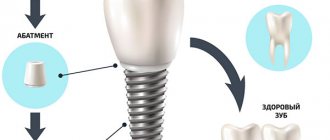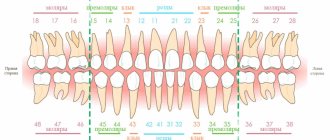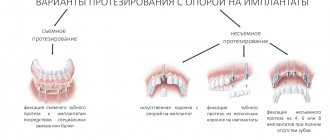A basal implant (root-shaped) is narrower in shape than a classic implant. It is installed in the deep layer of bone tissue (basal layer). Does not require an incision in the gums before installation. A small puncture is made in the gum, through which the implant is inserted into the bone (implantation without incisions!).
The method has gained great popularity in the countries of Eastern and Western Europe, Israel, and the CIS countries. Belarus is one of the leaders in the CIS countries in installing basal implants.
Why is basal implantation so popular today?
Not all clients are suitable for classical dental implantation due to the banal lack of bone tissue in order to fully implement it. Doctors have to resort to sinus lifting - artificial tissue expansion. However, this process increases not only the time spent on the procedure, but also the cost of the service.
Dental implantation, in addition, can be recommended to almost all people who need it, even those for whom conventional methods are simply not suitable physiologically. Just a few years ago, such patients had no chance. Today, thanks to advances in the medical field, they too will be “saved.” In general, implantation can be avoided if pulpitis and similar diseases are treated in time.
Indications and contraindications for basal implantation
Indications for basal implantation coincide with indications for traditional microprosthetics. An important nuance that orthopedic dentists pay attention to is the volume of bone tissue. If it is insufficient, which is caused by prolonged absence of teeth, then basal implantation will be the best option.
Microprosthetics with immediate load are performed in the absence of three or more teeth in a row. This allows you to create a uniform load on the pins and improve blood circulation in the tissues.
Contraindications for the procedure:
- oncology;
- blood diseases;
- diabetes;
- mental disorders;
- pregnancy.
Current limitations of basal implants
Still, basal implantation has some limitations. If you decide to resort to it, then first familiarize yourself with them. Although, of course, the clinic doctor will tell you about them at your appointment:
- It is impossible to place only one basal implant; at least three are needed. The load on such implants must be distributed evenly, otherwise it will be an inferior replacement for a real tooth and will not be able to fully perform all its functions.
- The period of time that must pass between the moment of installation of the “root” of the implant and its “top” is at least one year. This is exactly how much it will take for everything to take root. And for now you will have to go with a metal frame and a metal-plastic crown. It will be possible to install metal ceramics only after twelve months.
It should also be said that such an operation should only be carried out by a specialist of the highest class; this procedure requires true skill.
And finally, only a good doctor can determine whether this dental implant technology is suitable for a patient. He will be able to understand this from a panoramic photograph of the patient’s jaw.
Today the Republic of Belarus is a leader in the number of dental implants. And our DEC dental clinic is rightfully considered one of the leaders in the field of basal dental implantations in Minsk. Our specialists visit the largest medical centers in Switzerland, Germany and Israel to improve their skills.
Diagnostics and preparation at the Family Dentist clinic
During the consultation, the desired result of prosthetics is discussed and a dental rehabilitation plan is drawn up. First comes the orthopedic planning, then the surgeon selects the model and size of the implants. Our orthopedic dentist collaborates with the implantologist to determine whether the prosthesis will be aesthetic and functional. One-stage implantation is a team effort; it is necessary to undergo examination and treatment:
- 3D tomography is prescribed to determine the angle and depth of the rod, the presence or absence of pulpitis and granuloma, and the volume of the jaw bone.
- Sanitation is carried out to ensure the greatest possible sterility. The dentist removes plaque, treats caries and complications. The periodontist, using the Vector device, removes tartar, treats gum pockets, and relieves gum inflammation.
- Instructions are provided on the care of dentures on implants.
Make an appointment in advance for a consultation with a Family Dentist to determine the feasibility of basal implantation and prepare for the procedure. Our dentistry employs doctors with 15–20 years of experience. You can count on the competence and friendliness of the staff.
Recommendations for our patients after installation of basal implants
After the basal implants have been installed, each doctor at the DEC dental clinic gives the following recommendations:
- It is necessary within the first ten days, no matter how uncomfortable it may be, to begin loading the installed implants by chewing food. Only then will they begin to take root.
- The implant will take four to six months to take root. During this time, it can “settle” by several millimeters. You should not pay attention to this, especially since this is why metal-plastic rather than metal-ceramic crowns are installed in the first year.
Differences between basal implants and traditional forms
The basal implant is designed taking into account the main task - to recreate chewing function in case of insufficient bone mass by using the deep (basal) and biocortical layers of bone. Basal implants have a specific design: unlike traditional implants, they are located in the bone tissue in a special way and provide immediate loading with orthopedic structures.
The method of basal implantation has been known for a long time, but the first basal implants had a complex and very traumatic installation, which required mandatory detachment of the mucoperiosteal flap and cutting out a large amount of bone tissue using a cutter. Modern basal implants look completely different and do not have such disadvantages. Basal implants differ from classical implants not only in the shape of the subgingival part; they also have permanent abutments. The abutment is the supragingival part of the implant onto which the artificial crown is fixed.
To summarize: why our clinic does basal implantation in Minsk
Today we can offer our patients this method of implantation, as one of the most effective in several respects:
- It is a one-stage procedure - the operation can be performed immediately after tooth extraction.
- Fast. At the DEC dental clinic, up to twenty implants can be placed in a week, if necessary. When using the classical method, this takes from four to six months.
- Cheap - to carry out a full cycle, fewer surgical interventions are required, and, accordingly, less work for the surgeon. And, as a result, all procedures cost less.
- With this method, the patient’s adaptation to normal life takes virtually no time. Once the implant is installed and the necessary post-procedures are carried out, the person can live as usual
- Suitable for almost everyone - even heavy smokers who are contraindicated for classical implantation.
As for calculating the specific cost of basal dental implantation in Minsk and the price of such an operation, everything is individual. A personal plan for completing all procedures is developed for each client, and depending on the required number of procedures, the total amount that the entire process will cost him is determined.
The entire implantation process is carried out according to protocols approved by the Ministry of Health of the Republic of Belarus.
Implantation without gum incisions
The key advantage of single-phase (one-stage) implants is the low-traumatic nature of their installation during surgery. In cases where implants are installed in a cavity that has already formed after extractions, the implantologist makes a careful puncture in the gum. Through this puncture, the doctor gains access to the bone structure, where the implant is subsequently inserted. After installing the implant, the gums do not need to be sutured, since no incisions were made.
Unlike classical implantation, in which it is necessary to first cut the gum and detach the gum flaps to access the bone structure. And after installing the implant, sew up the gum with several stitches. After 7-10 days, the stitches are removed.
Let's look at the features of using the basal implantation technique in more detail:
- Possibility of installing and splinting implants in one stage (immediately after tooth extraction), i.e. there is no need to wait 2 months until the bone returns to normal after removal.
- Complete installation of prostheses is carried out in Minsk immediately after their manufacture in 3-5 days. Therefore, there is no need to wait 4-6 months for the implants to take root.
- Considering that the total number of appointments and surgical interventions is decreasing, the cost of treatment is correspondingly decreasing.
- The ability to return to your previous lifestyle immediately after completion of the procedures and installation of permanent prostheses.
- In addition, basal osseointegrated implants are the best solution for smokers for whom conventional implantation systems are contraindicated.
In our dental centers for foreign patients, the treatment schedule is drawn up according to an individual plan, with the ability to pre-orient the patient on the cost of basic and additional procedures. Within 7 days, a set of procedures for implanting from 2 to 20 units of implants can be performed.
Especially for our clients, we have prepared a detailed description of the entire process of basal implantation in our clinic in Belarus.
To draw up a treatment schedule, our doctors first need to familiarize themselves with a panoramic image of the patient. You can take a picture in most dentists in your city, then pick up the electronic version on disk and send it to us by e-mail, to the address You can also send a 3D computed tomography.
Cost of dental implantation
| from March 1-15 DISCOUNTS up to 20% | BYN | PRICE WITH DISCOUNT |
| Installation of the MIS Seven, M4 implant (one of the world's 10 best manufacturers) The price includes: examination by a doctor, work on installing the implant under anesthesia, cost of the implant. | 744 | 595 |
| Installation of the MIS C1 implant | 749 | — |
| Installation of the healing abutment | 85 | — |
| One-stage UNO implantation | 660 | 627 |
| One-stage implantation UNO Narrow | 720 | 684 |
| Temporary implants, orthodontic | 610 | 579 |
Why implantation should be done as early as possible
After removing diseased teeth from the roots, it is necessary to contact the clinic for implantation within 2-6 months, because:
- Without chewing load, the jawbone in the defective area becomes thinner. Chewing soft food on the gums is not enough stress.
- Due to shifting loads, chronic pain appears in the jaw muscles and joints.
- Due to the absence of teeth, facial features and speech are distorted.
- Installation of a bridge does not put a load on the edentulous area, but overloads the adjacent teeth that have become supporting teeth. The method involves depulping and grinding them down. Teeth break and the bone tissue around them becomes deformed.
Implantation prevents further destruction of the masticatory apparatus, ensures complete chewing of familiar food, preserves a natural smile and psychological comfort when communicating.
The difference between classical implantation and basal implantation
If jaw bone atrophy has not yet begun, classic implantation using the All-on-4 method is used. If atrophy is present, but not very pronounced, the classic All-on-6 method is recommended. Both technologies were developed and patented by the Swiss company Nobel Biocare.
All-on-4 technology – everything on four
4 implants are implanted into the jaw: 2 perpendicularly in the frontal area, 2 in the area of 5-6 teeth at an angle of 30-45°. The design ensures high stability of the prosthesis without building up bone tissue. The operation lasts 1.5 – 2.0 hours under local anesthesia.
Crown material for All-on-4/6 prosthetics
In the manufacture of prosthetics, we use innovative high-quality materials. Practical experience in using metal-acrylic crowns has shown that this is not the most reliable material. During use, such prostheses darken, wear out and break. There is a need to replace the prosthesis with a more durable material within a year after installation.
We abandoned the use of this material in favor of cold polymerized plastic Top.Lign Professional. The reliability and durability of this certified German material is due to the resistance of the plastic. Manufactured dentures have a more aesthetic appearance. Detailed comparative characteristics can be found in the table:
| Characteristics | Metal acrylic prosthesis | Prosthesis made of cold polymerized plastic Top.Lign Professional |
| Prosthesis weight | Big | Smaller |
| Presence of a metal base | Eat | Absent |
| Strength | Smaller; the material is more fragile and more often susceptible to mechanical damage | Large; the material is more flexible and durable |
| Timing of prosthetics | 7 calendar days | 1 calendar day! |
| Life time | 1-1.5 years | Up to 3 years |
Immediate implantation
Sometimes the dentist decides on immediate implantation. Although it is difficult to prepare an ideal prosthesis without clear data, in some cases it is necessary:
- inability to set a dislocated tooth
- Chronic periodontitis, extending to both the root and crown
- displacement of a tooth root due to a fracture
- first and second degree periodontitis
- chronic periodontitis that is not amenable to conservative treatment
This procedure is performed only after bone formation is complete.











